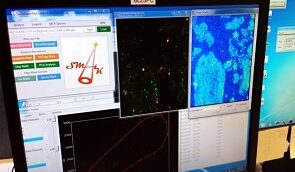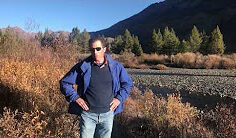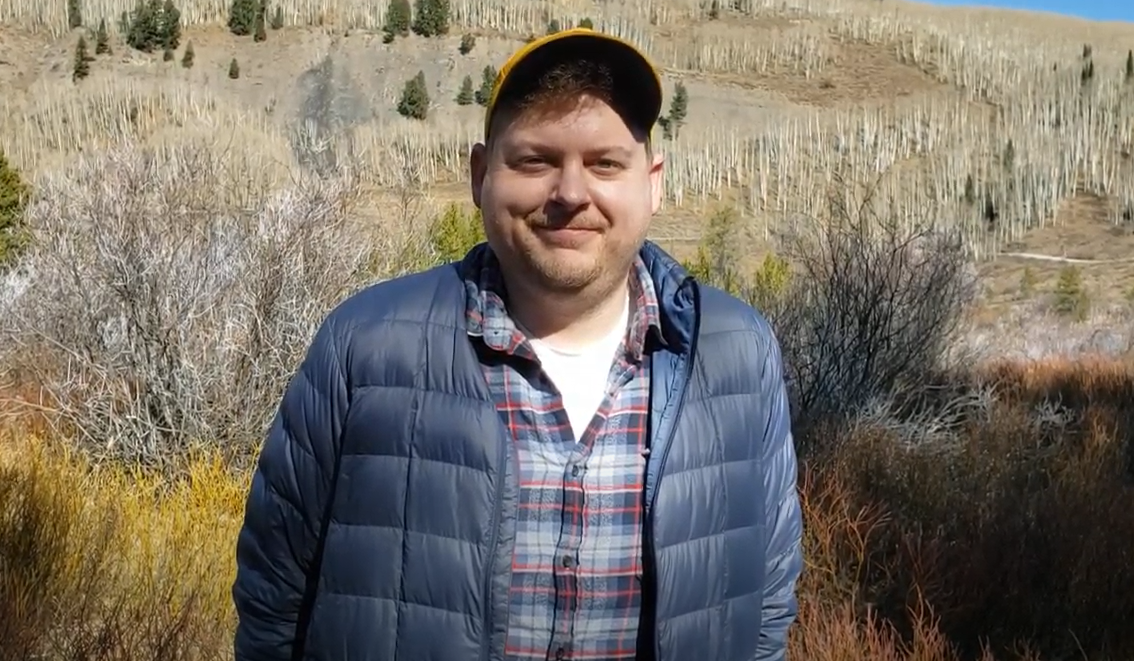Floodplain Hydro-Biogeochemistry Science Focus Area
This Science Focus Area (SFA) closed in 2024. To see the latest ongoing research by this team, go to Watershed Function SFA.
Understanding the hydro-biogeochemical reactivity of subsurface interfaces.
Project website | Overview brochure PDF
- Principal investigator: Kristin E. Boye
- Co-principal investigators: Kate Maher, Scott Fendorf, Sharon Bone, Vincent Noel
- Annual reports: 2019 | 2018 | 2016 (Note: Reports are not issued during review years.)
Groundwater in the western United States is increasingly threatened by intensifying drought and diminishing snowpack. The loss of subsurface moisture promotes oxidative transformations of trace metals such as iron, manganese, zinc, and copper, which are important both as micronutrients and, in some cases, as contaminants. Molecular transformations of these metals—mediated by microbial and abiotic processes—degrade groundwater quality, presenting a major threat to water resources and, thus, U.S. energy and economic security. Moreover, hydro-biogeochemical processes promote the spread and persistence of uranium and metals in groundwater at contaminated Department of Energy (DOE) legacy sites, which are a major concern in mining-impacted and drought-stressed floodplains in the West.
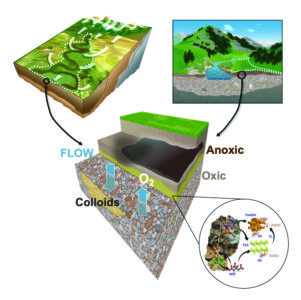
Hydro-Biogeochemical Process Coupling at Subsurface Interfaces. The SLAC SFA is linking molecular behavior to hydrological triggers and biogeochemical processes at subsurface interfaces. The goal is to develop a systems understanding of floodplain groundwater quality at watershed scales in response to drought and extreme weather. The interface (shown above) between shallow, fine-grained anoxic sediments and the underlying gravel bed is ubiquitous in the western United States.
The coupling of hydrological and biogeochemical processes is particularly robust at subsurface interfaces, where contrasting sediment permeability creates sharp gradients of dissolved solutes and redox conditions. Transport of reactive solutes across interfaces, in response to infiltration, upwelling, and diffusion, creates disequilibrium conditions and supplies nutrients that support microbial growth, stimulating intense biogeochemical activity. The hydrological, microbiological, and geochemical steps involved, as well as their sequencing, timing, duration, and molecular products, are poorly understood. Yet, these parameters are critically needed in models to predict groundwater quality in response to diminishing annual snowpack and overall precipitation in the western United States. Additionally, evidence suggests that colloids generated at subsurface interfaces help control the transport of organic carbon and metal micronutrients and contaminants across floodplains and watersheds. These processes are also not captured adequately in biogeochemical reactive transport models nor at larger scales (e.g., watershed hydro-biogeochemical models).
To address these knowledge gaps, the Floodplain Hydro-Biogeochemistry Science Focus Area (SFA) led by SLAC National Accelerator Laboratory (SLAC) is tackling the question of how subsurface interfaces mediate molecular-scale biogeochemical processes and groundwater quality. The program is supported by DOE’s Office of Biological and Environmental Research (BER) as part of BER’s Environmental System Science (ESS) program. Field observations, along with laboratory investigations, are focused on floodplains at Riverton, Wyoming, and Crested Butte, Colorado.
Key Concepts and Vision
The SLAC SFA is investigating the mechanisms by which hydrological and biogeochemical processes couple in floodplains to understand their impact on groundwater quality. Accurate, observationally founded molecular-scale process understanding is essential for predicting changes in groundwater quality and floodplain subsurface functions over time and space in response to intensifying drought, warming soils, and more intense storm events. This program advances understanding of three key concepts:
- Subsurface flow events (seasonal, daily, or episodic) activate biogeochemical reaction networks and trigger myriad molecular-scale microbial and geochemical responses.
- Subsurface interfaces are the nexus wherein flow and biogeochemical reactions couple to control floodplain groundwater quality.
- Reactive transport modeling provides a path for predicting groundwater quality responses to long-term hydrological and temperature changes in the Earth system. Better understanding of these central concepts will transform the ability to forecast and manipulate floodplain groundwater quality.
Hydro-Biogeochemical Coupling Mechanisms
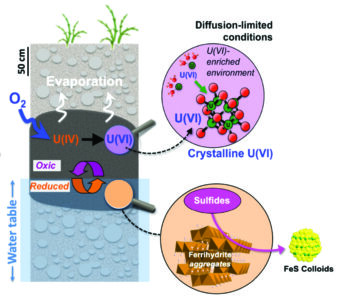
Molecular Transformations and Water Quality Responses to Hydrological Triggers. Loss of moisture due to evapotranspiration causes biogeochemical oxidation of uranium and precipitation of uranium-bearing minerals. These processes sequester this contaminant and protect groundwater quality. Waterlogged sediments, on the other hand, produce iron sulfide colloids, which can pick up and transport contaminant metals, degrading water quality. Click image to enlarge.
Hydrological events such as daily evapotranspiration or flooding modify sediment moisture and transport dissolved solutes such as oxygen, major cations and anions, and trace metals across subsurface interfaces. Microorganisms residing within these sediments respond to changing moisture and nutrient availability by producing reactive constituents such as sulfide and iron [Fe(II)] and triggering periods of intense biogeochemical activity often referred to as “hot moments.” Mixing of reactive solutes across subsurface interfaces stimulates further reactions, including the formation of colloids rich in organic carbon and trace metals. Understanding the timing, duration, and direction of flow, as well as the connected biogeochemical reaction networks, ultimately will enable prediction of the generation and transport of reactive solutes, trace nutrients, and contaminants in floodplain systems and the ensuing impacts on groundwater quality.
Subsurface Interfaces as the Nexus of Hydro-Biogeochemical Activity
Sediment layering in floodplains (e.g., shallow fines overlaying basal gravel and cobble) juxtapose sharply contrasting permeability and flow conditions, mineralogy, redox conditions, and elemental abundances, making them ecosystem control points for biogeochemical activity. These interfaces have repeatedly been shown to have outsized impacts on groundwater quality. In spite of their importance, however, processes and solute transport across subsurface interfaces are not well understood.
Role of Colloids
Colloids are known vehicles of nutrient, organic carbon, and contaminant transport. SFA findings have shown that subsurface interfaces not only exhibit intense and altered biogeochemical activity, they also promote the formation of colloids. These colloids may be deposited near interfaces, stimulating biogeochemical reactions that generate zones of reducing conditions. Alternatively, they may enhance transport of nutrients and metals to recipient stream water. Because of strong exchange flows between streams and gravel-bed floodplains, colloids and solutes exported from one floodplain can be redeposited in floodplains downstream, linking biogeochemical functions along the entire riparian corridor. Accounting for colloid formation, transport, reactivity, and interaction with sediment matrices is key to understanding floodplain biogeochemical functions and groundwater quality dynamics.
Linking to Other BER Model Frameworks
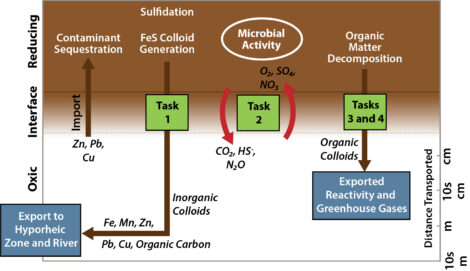
Linking Molecular Processes to the Water Cycle Across Subsurface Interfaces. In four coupled subtasks, the Floodplain Hydro-Biogeochemistry SFA is using field investigations and laboratory experiments to better understand what controls biogeochemical responses to hydrological changes and their impact on contaminant and nutrient transport at and across subsurface interfaces. Ultimately, this quantitative process knowledge will support watershed-scale hydrological and reactive transport modeling in the ESS program.
The Floodplain Hydro-Biogeochemistry SFA is improving the ability to mechanistically link the water cycle to nutrient and contaminant mobility in the shallow subsurface. The goal to implicitly include colloid generation, transport, and reactivity in model representations will improve water quality prediction far beyond current capabilities. Process models developed by the Floodplain Hydro-Biogeochemistry SFA complement and feed into watershed hydrological model frameworks being developed by other ESS SFA programs, such as the Interoperable Design of Extreme-scale Application Software (IDEAS)-Watersheds project.
Videos
X-ray Microprobes in Water Quality Models
John Bargar shows how an X-ray microprobe can be used to develop models to manage water quality and predict our nation’s water availability. (2018)
Meet the Scientist: John Bargar
John Bargar describes work being performed within the greater East River Watershed associated with the DOE-funded Groundwater Quality SFA. (2017)

